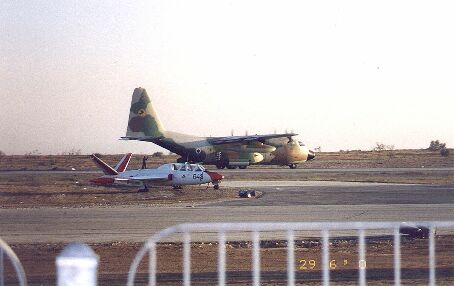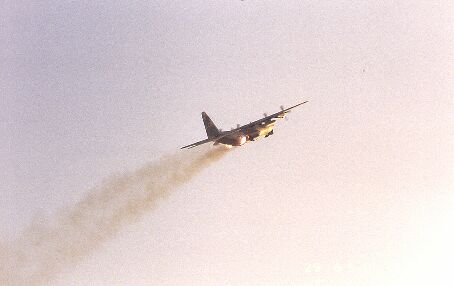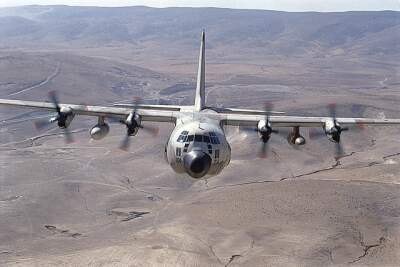Israel first expressed an interest in acquiring the Hercules during the early 1960s. The U.S. administration however, was at the time unwilling to provide Israel with any military hardware and it was only towards the end of the decade, with the warming up of US-Israeli relations, that the IAF was allowed to purchase the type. The first two C-130Hs arrived in Israel in October 1971 and entered service with the 120th "International" squadron at Lod Airport, alongside Boeing Stratocruisers. Nicknamed "Karnaf" (rhinoceros), the type was soon utilized to ferry men and equipment to Rephidim, transportation center for IDF forces in the Sinai peninsula.
The C-130's excellent load capacity and its ability to land on unpaved airstrips was put to use once the Yom Kippur broke out in October 1973, the two aircraft flying ammunition, fuel and other equipment to Israeli forces battling the invading Arab armies on the various fronts. The IAF's heavy lift capability however, was insufficient for the needs presented by the war, leading to a 120th squadron requirement for more aircraft. In a meeting with IAF Commander Benny Peled, the squadron commander, Lieutenant Colonel David Porat, and his deputy, Major Yehoshua Shani, sought to hasten the arrival of two more C-130Hs, destined for delivery later in the year. Peled however, seized the opportunity to request more than these two aircraft.
 Within a week, on October 14th, twelve former USAF C-130Es arrived at Lod Airport as part of operation "Nickel Grass", the American emergency airlift to Israel during the war (also known as operation "Manof", crane, its Israeli name). The new aircraft enabled the formation of a new Hercules squadron, the 131st "Ha'Tzipor Ha'Tzehuba" (The Yellow Bird) squadron, which also received the 120th's two C-130Hs. Command of the squadron was given to Porat, while Shani was awarded command of the 120th sqn., now solely a Stratocruiser unit. The biggest obstacle in operating the new aircraft was the lack of aircrews, only four certified C-130 captains available at the time. The 131st nonetheless succeeded in training new crews and manning its aircraft, using every available pilot to fly the planes as well as drafting men from Israel's national carrier, El Al. Another problem encountered with the former American planes was their bad mechanical state, resulting from over ten years of service. Once these problem were overcome the new squadron was integrated into IAF operations, the new aircraft still wearing their USAF livery. The C-130Es flew over 180 hours during the war and among other missions, participated in the Israeli airlift to Nahshon, the Egyptian air base at Faid captured during the Israeli incursion into mainland Egypt.
Within a week, on October 14th, twelve former USAF C-130Es arrived at Lod Airport as part of operation "Nickel Grass", the American emergency airlift to Israel during the war (also known as operation "Manof", crane, its Israeli name). The new aircraft enabled the formation of a new Hercules squadron, the 131st "Ha'Tzipor Ha'Tzehuba" (The Yellow Bird) squadron, which also received the 120th's two C-130Hs. Command of the squadron was given to Porat, while Shani was awarded command of the 120th sqn., now solely a Stratocruiser unit. The biggest obstacle in operating the new aircraft was the lack of aircrews, only four certified C-130 captains available at the time. The 131st nonetheless succeeded in training new crews and manning its aircraft, using every available pilot to fly the planes as well as drafting men from Israel's national carrier, El Al. Another problem encountered with the former American planes was their bad mechanical state, resulting from over ten years of service. Once these problem were overcome the new squadron was integrated into IAF operations, the new aircraft still wearing their USAF livery. The C-130Es flew over 180 hours during the war and among other missions, participated in the Israeli airlift to Nahshon, the Egyptian air base at Faid captured during the Israeli incursion into mainland Egypt.The end of the Yom Kippur War allowed the IAF to refurbish its Hercules fleet and the C-130Es were brought up to H standard, with new engines and avionics. Between May 1974 and November 1976 eight new C-130Hs also joined the IAF, 2 of which were KC-130H tankers. All eight entered service with the 103rd "Ha'Pilim" (The Elephants) squadron, replacing its aging Nord Noratlases. On November 25th 1975 the IAF suffered its sole Hercules loss, when a C-130H which had taken off from Rephidim AFB flew into Jabel Hilal in bad weather, killing all 20 people on board. When Palestinian terrorist hijacked an Air France Airbus to Entebbe, Uganda, "Yellow Bird" C-130s carried out one of the IAF's best known operations, "Kadoor Ha'Raam" (Thunderball), also known as operation "Jonathan". On the afternoon of July 3rd 1976, four Karnafs took off for Uganda, carrying elite Israeli strike forces. Leading the four Hercules was Lieutenant Colonel Yehoshua Shani, by now the "Yellow Bird" squadron leader. After a 7 hour flight the aircraft landed in Entebbe in total surprise and within 51 minutes the Israeli commandos overcame the hijackers and departed for Israel with the rescued hostages on board. Astounding the world, the operation marked a milestone in confronting international terrorism.
Israel's 1982 invasion of Lebanon saw the Hercules support Israeli ground forces once again. As Israeli forces pushed deeper into Lebanon and captured a number of airstrips, IAF C-130s begun landing at locations very close to the battlefield. During the three years of Israel's occupation of Lebanon, the C-130s often flew Israeli troops in and out of the Beirut region, avoiding possible guerilla attacks on the ground.
 On May 24th 1991 Israel launched operation "Solomon" to rescue Ethiopian Jews caught in the midst of Ethiopia's civil war. 18 IAF C-130s participated in the operation, flying along IAF Boeing 707s as well as Israeli and Ethiopian civil airliners. 18 Hercules sorties were flown throughout the operation and each aircraft carried roughly 150 passengers. IAF C-130s were once again flying in Africa during July 1994, as part of operation "Nitzanei Tikva" (Sprouts of Hope). In the midst of the civil war in Rwanda, IAF C-130s and Boeing 707s flew to Goma, on the Rwanda-Zaire border, carrying equipment for a field hospital, medicine and a medical team. Among the pilots flying the 707s was once again Yehoshu Shani, by now a reserve IAF Brigadier General. More recent Hercules missions include transporting an Israeli rescue team and much need supplies to the victims of the August 1999 earthquake in Turkey. 25 Hercules sorties were flown to Turkey, while three more aircraft were dispatched to Greece in September when an earthquake hit that nation as well. IAF C-130s were once again in Greece during the summer of 2000, providing support for IAF CH-53s battling severe forest fires.
On May 24th 1991 Israel launched operation "Solomon" to rescue Ethiopian Jews caught in the midst of Ethiopia's civil war. 18 IAF C-130s participated in the operation, flying along IAF Boeing 707s as well as Israeli and Ethiopian civil airliners. 18 Hercules sorties were flown throughout the operation and each aircraft carried roughly 150 passengers. IAF C-130s were once again flying in Africa during July 1994, as part of operation "Nitzanei Tikva" (Sprouts of Hope). In the midst of the civil war in Rwanda, IAF C-130s and Boeing 707s flew to Goma, on the Rwanda-Zaire border, carrying equipment for a field hospital, medicine and a medical team. Among the pilots flying the 707s was once again Yehoshu Shani, by now a reserve IAF Brigadier General. More recent Hercules missions include transporting an Israeli rescue team and much need supplies to the victims of the August 1999 earthquake in Turkey. 25 Hercules sorties were flown to Turkey, while three more aircraft were dispatched to Greece in September when an earthquake hit that nation as well. IAF C-130s were once again in Greece during the summer of 2000, providing support for IAF CH-53s battling severe forest fires.IAF C-130s continue to be the mainstay of Israel's tactical airlift capability, but are also active on many other roles. The Hercules is the standard training platform for IDF paratroops, and several may have been adapted for electronic warfare as well. IAF KC-130s are capable of refuelling a multitude of IAF aircraft, including CH-53s, UH-60 Black Hawks, F-4 Phantoms and even F-16s, using underwing HDUs (Hose Drum Units). Israeli C-130s are themselves capable of refuelling from both the KC-130, using a refuelling probe, as well as from IAF Boeing 707s, using an inflight refuelling boom receptacle.
The IAF has recently begun looking at possible replacements for its aging C-130 fleet. Lockheed Martin has apparently offered Israel the C-130J, the latest variant of the Hercules. One C-130J visited Israel in 1998 and was flown by Israeli pilots.

 back to the IDF/AF page
back to the IDF/AF page